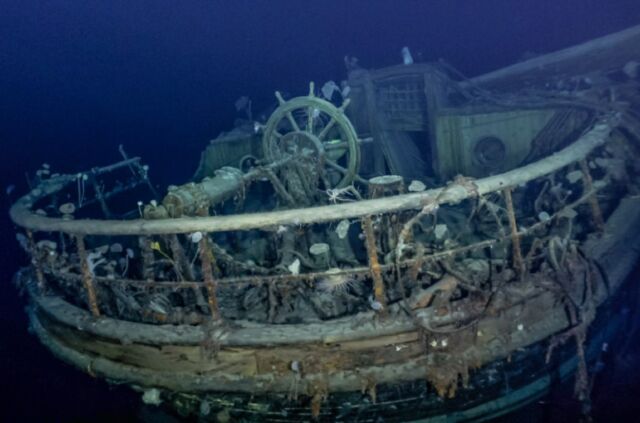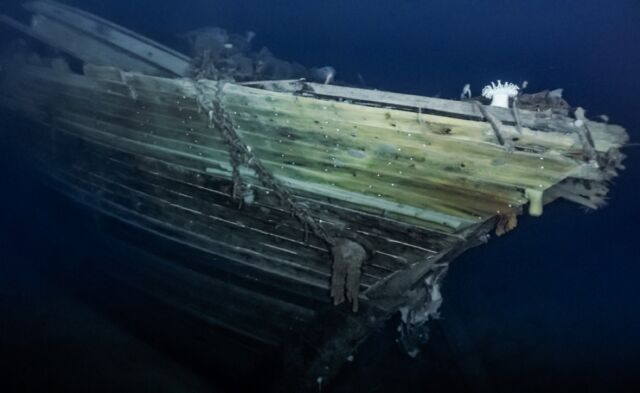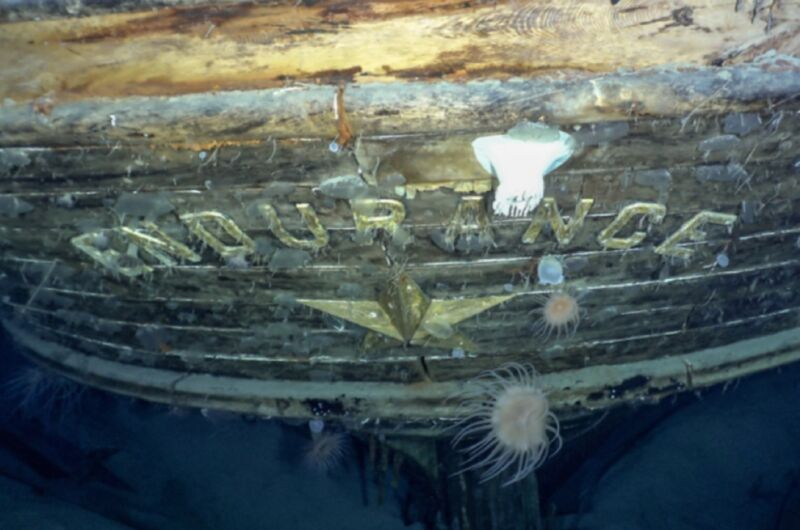In 1915, intrepid British explorer Sir Ernest Shackleton and his crew were stranded for months on the Antarctic ice after their ship, Endurance, was crushed by pack ice and sank into the freezing depths of the Weddell Sea. Today, the Falklands Maritime Heritage Trust and National Geographic announced the discovery of this famous shipwreck, nearly 107 years later, 3,008 meters down, roughly four miles south of the ship's last recorded position.
The shipwreck is in pristine condition partly because of the lack of wood-eating microbes in those waters. In fact, the Endurance22 expedition's exploration director, Mensun Bound, told The New York Times that it's the finest example he's ever seen; Endurance is "in a brilliant state of preservation." The expedition has released the first images of the wreck—the first time anyone has laid eyes on Endurance since her sinking a century ago. They included shots of the stern (with "ENDURANCE" clearly visible), the rear deck and ship's wheel, and parts of the deck and hull.
A survival story
Endurance set sail from Plymouth on August 6, 1914, with Shackleton joining his crew in Buenos Aires. By the time they reached the Weddell Sea in January 1915, accumulating pack ice and strong gales slowed progress to a crawl. Endurance became completely icebound on January 24, and by mid February, Shackleton ordered the boilers to be shut off so that the ship would drift with the ice until the weather warmed sufficiently for the pack to break up. It would be a long wait. For 10 months, the crew endured the freezing conditions. In August, ice floes pressed into the ship with such force that the ship's decks buckled.

The ship's structure nonetheless remained intact, but by October 25, Shackleton realized Endurance was doomed, and he and his men opted to camp out on the ice some two miles away, taking as many supplies as they could with them. Compacted ice and snow continued to fill the ship until a pressure wave hit on November 13, crushing the bow and splitting the main mast—all of which was captured on camera by expedition photographer Frank Hurley. Another pressure wave hit in late afternoon November 21, lifting the ship's stern. The ice floes parted just long enough for Endurance to finally sink into the ocean, before closing up again to erase any trace of the wreckage.
When the sea ice finally disintegrated in April 1916, the crew launched lifeboats and managed to reach Elephant Island five days later. Shackleton and five of his men set off for South Georgia the next month to get help—a treacherous 720-mile journey by open boat. A storm blew them off course, and they ended up landing on the unoccupied southern shore. So Shackleton left three men behind while he and a companion navigated dangerous mountain terrain to reach the whaling station at Stromness on May 2. A relief ship collected the other three men and finally arrived back on Elephant Island in August. Miraculously, his crew was still alive.

Shackleton died several years later during the Quest expedition to Antarctica, which set sail in 1921. He never reached their planned destination, falling ill in late December just as the ship was about to leave Rio. He had begun drinking heavily to "deaden the pain," despite not usually allowing alcohol while at sea. They reached South Georgia on January 4, 1922, and Shackleton made his final diary entry before retiring to bed.
By 2 am, he was complaining of back pains and requesting painkillers. Ship physician Alexander Macklin suggested he might try leading a more normal life. Shackleton asked what Macklin thought he should give up. "Chiefly alcohol, boss, I don't think it agrees with you," the physician replied. Then Shackleton "had a very severe paroxysm" and died. The official recorded cause of death was coronary thrombosis.



3175x175(CURRENT).thumb.jpg.b05acc060982b36f5891ba728e6d953c.jpg)

Recommended Comments
There are no comments to display.
Join the conversation
You can post now and register later. If you have an account, sign in now to post with your account.
Note: Your post will require moderator approval before it will be visible.